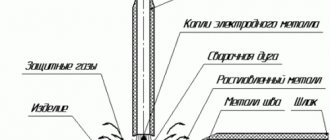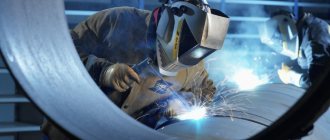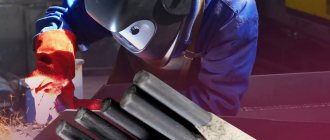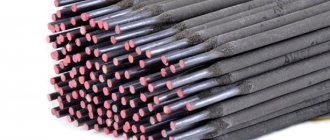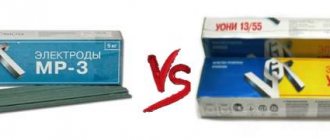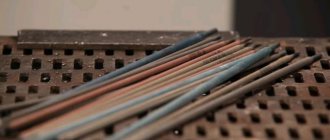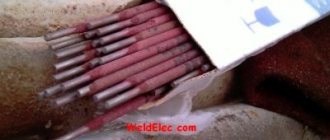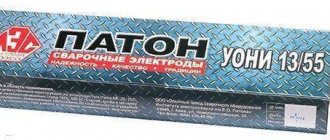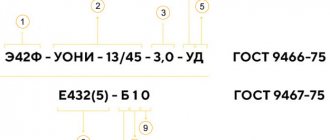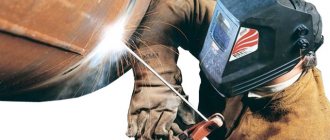Manual arc welding of aluminum and its alloys with a coated electrode is not used so often , but this technological process is the cheapest and simplest . Welding aluminum with a coated electrode is more suitable for field conditions and small repair shops.
Aluminum electrodes are coated with a composition of chlorides and fluorides of alkali and alkaline earth metals, which melt under the influence of an arc and vigorously react with aluminum oxide to form complex compounds that turn into slags or volatile compounds. Through the coating, if necessary, it is possible to additionally alloy the weld metal. But basically alloying of the weld metal is carried out by selecting the appropriate composition of the rod.
Manual arc welding with a coated electrode is used in the manufacture of structures from technical aluminum, AMg and AMts alloys containing up to 5 percent magnesium and aluminum-silicon alloys.
The thickness of the welded parts is limited by the diameter of the electrode, which, as a rule, is 4-5 mm. Welding with small-diameter electrodes is fraught with difficulties due to the high melting rate (2-3 times faster than steel) of the electrode rod. In this regard, the thickness of the welded metal should not be less than 4 mm. Electrodes for aluminum welding with a diameter of 3.0 mm are produced with a length of 225-300 mm, and with a diameter of 4-5 mm, a length of 350-450 mm.
See also: “Welding of aluminum“
Electrodes for welding aluminum and aluminum alloys: technical features
Aluminum is one of the most difficult metals to weld . The properties of this metal significantly complicate the welding process, so large enterprises very rarely use manual welding with electrodes. For this, special equipment is used.
However, at home or in small workshops, the use of special equipment can be expensive and unprofitable . Therefore, in such conditions, the use of manual arc welding is allowed.
The main features of aluminum that complicate the welding process:
- Oxide film . It forms on the surface of aluminum products and creates additional problems, since its melting requires a temperature of more than 2000 ° C. Despite the fact that aluminum itself begins to melt at 600°C.
- It's hard to make a seamless seam . The metal quickly oxidizes and a refractory film appears on the molten drops. Therefore, it is necessary to take measures to reduce the level of oxygen in the environment (with the help of special equipment this is easier to do than manually).
- Aluminum melts quickly and spreads strongly . When welding, heat-dissipating pads must be used.
- Tendency to form crystallization cracks . Most aluminum alloys contain silicon. Because of this, splits may form when welding seams.
- High linear expansion . During the hardening process of the seam, the shape may become deformed.
- To weld aluminum structures and parts, you need to use a current 1.5 times stronger than when working with other metals.
[ads-pc-2][ads-mob-2]
Production allowance
Any of the listed types of rods is an expensive pleasure. You can save money and make the consumables yourself. The Internet is full of videos demonstrating the process of making electrodes.
We also want to tell you the secret of making electrodes at home. Follow the instructions:
- Cut blanks from aluminum wire. Their diameter should be no more than 4 mm, and their length should be approximately 20-25 cm. These twigs are quite enough, you can change them. For the top layer, mix crushed white chalk with silicate glue, also known as “liquid glass,” until smooth. We dip the twigs in it.
- It is important that the top ball is no more than 2 mm. We leave everything to harden. After the coating has dried, everything is ready for use.
- A seam with their help will, of course, be far from ideal, but it will be quite suitable for some simple work. You may be skeptical about this method of making rods at home, but they can really come in handy around the house and save your budget.
Remember that this is not a factory product so for a quality weld to do a good job, it is better to test the electrode on a scrap piece of metal.
Characteristics of electrodes for aluminum arc welding
Arc welding is a profitable and simple option when processing structures made of aluminum or its alloys. In this case, coated consumable electrodes are used.
One of the main features of aluminum electrodes is their fast melting rate. Therefore, welding occurs 2-3 times faster than when working with other metals.
When welding stops (or when the arc breaks), a layer of slag forms at the end of the rod, as well as on the surface of the crater of the weld pool. This makes it difficult to re-ignite the arc. It is recommended to cook continuously with one electrode until the consumable is completely melted.
Advice from professionals
In the absence of experience, choosing consumables and connecting aluminum elements is not easy. Therefore, the advice of the masters will come in handy.
- It is better when the composition of the workpiece and the alloy of the aluminum electrodes exactly match each other. You can check this using the information on the packaging.
- The cross-section of the electrodes for welding must correspond to the wall thickness. If you cook a thin sheet with a thick rod, then burnout is inevitable.
- The difference in thickness is allowed no more than 1 mm.
- Consumables dried 2-3 times lose quality and are not recommended to be used.
- Preliminary cleaning of the edges processed by welding is mandatory.
- Beginner welders should start with thick parts. The welding process proceeds very quickly, and thin metal is easily burned through.
- Aluminum is characterized by increased fluidity, so it is quite difficult to obtain a thin seam.
- The thicker the metal being welded, the longer it takes to warm up the electrodes before work.
- Moderate currents contribute to good melting of the base metal.
- It is better to heat thick workpieces in sections. The finished seam is cleaned of slag, washed with hot water, treated with a brush and boiled further.
Coating of aluminum electrodes
The coating of electrodes intended to work with structures made of pure aluminum or its alloys is made from chlorides and fluorides of alkali and alkaline earth metals. This composition of the coating allows it to react with aluminum oxide during the burning of the welding arc. In this case, complex compounds are formed that turn into slag.
Depending on the specific task, consumables with different coating compositions are selected. Some types allow alloying of the weld metal by adding additional elements to the coating composition. Although most often alloying is done due to the special composition of the rod.
Electrodes for inverter welding
You can often hear a question from inexperienced welders about whether it is possible to weld aluminum using an inverter.
And what electrodes to use? The answer to this question is very simple - if you do not have special equipment and you decide to weld with electrodes, you must use an inverter. Since aluminum is a difficult metal to weld, the use of an inverter will ensure the formation of an even and high-quality seam. Here are the main advantages of the inverter:
- Consumes relatively little electricity . In this case, high efficiency is achieved.
- Protects against voltage surges and allows you to maintain a stable current throughout the entire welding process.
- Compactness of the device. It has small dimensions and is convenient to use in any conditions.
- Can work with difficult to compatible alloys .
- Any type of electrode can be used . Therefore, all coated electrodes that can be used for welding work on aluminum structures are suitable for the inverter.
IMPORTANT! When welding aluminum, you must use direct current of reverse polarity.
In this case, cathode sputtering is formed, which destroys the oxide film on the metal surface. If you use straight polarity, the film will not collapse, and welding the structure will be very difficult. With reverse polarity, there should be a stable supply of strong current. Since a decrease in current strength can lead to poor combustion of the welding arc and the formation of a poor seam. The inverter will help maintain the desired current level and ensure stable welding.
Ways
Most often, tungsten electrodes are used for welding aluminum, as well as carbon and graphite electrodes, depending on the process method.
Manual electric arc
This type of welding of aluminum with a coated electrode is performed using a carbon or metal electrode.
The round type of vikorist is used for welding pipes in the forks, connecting the tires to aluminum. In some cases, it is also necessary to combine materials with a small amount of flanging work.
In these cases, filler material is used, which serves as rods coated with flux.
Welding of aluminum with a carbon electrode is carried out in a constant stream with direct polarity, stagnant carbon or graphite analogues of any diameter.
Video:
Coated metal electrodes are prepared from a blast furnace and then a mixture of chloride and fluoride salts is applied to them.
It is necessary to mix water and sodium chloride in a jar of fruit, for these purposes the dextrin is mixed and dextrin is used.
Automatic electric arc
Automatic electric arc welding is carried out to melt and vicorize metal for welding, which causes damage to more than 4 millimeters.
It operates on a steady stream of reversal polarity.
To weld aluminum, use fluxes that may reduce electrical conductivity.
Mix the flux with a mixture of carboxymethylcellulose and water, rub through a sieve, and then fry at a temperature of 280 - 320 degrees for 6 years.
Most often it is carried out with a split electrode.
Dugovoy, in the middle of dry gases
This type is also widely used for bonding with aluminum. Argon is contaminated with a dry gas and has a purity of at least 99.9%.
It is common to use argon and helium for these purposes.
In the middle of the dry gases, the arc welding is vibrated with tungsten electrodes.
Due to the high resistance of the arc, it can be used for even thin metal sheets. Brewing is carried out using a variable steamer and can be carried out manually or automatically.
The manual arc welding is made with viscosity tungsten electrodes and an additional dart.
The automatic process operates with the supply of additive, but it can also be carried out without it.
For welding aluminum, the process of welding with a tungsten electrode with a pulsed arc is also used - for thin sheets, with a tungsten electrode with a heated arc - for sheets with high durability.
For aluminum alloys, vicoristics use three-phase arc welding, in which it is possible to regulate the heat input to the metal of various materials.
Video instructions:
In one pass, using this method, you can weld metal that is over 30 mm thick.
Plasmovium
Plasma welding is characterized by high fluidity, which is an advantage. With it, the thermal influx zone significantly shortens and the process stabilizes.
For aluminum, plasma welding is combined with arc welding and a changeable jet.
When choosing this type, use tungsten electrodes with a diameter of 0.8 mm to 1.5 mm. The chemical gas can be 99.98% argon or 99.95% helium.
Popular brands of aluminum electrodes
Now we will describe the common brands, what these brands are called and what features the materials bearing these names have.
The industry of the CIS countries produces electrodes of the OZA and OZANA series, as well as electrodes of the UANA series. The coating of electrodes of the OZA and OZANA series has high hygroscopicity and low strength and consists of chloride and fluoride salts of lithium and potassium, which intensively interact with aluminum oxides, turning them into slag.
- OZA-1 products are made from SvA1 aluminum wire and are intended for welding pure aluminum, and OZA-2 electrodes, made from SvAKZ, SvAk5 or SvAK10 wire, weld aluminum-silicon alloys.
- OZANA-1 products are made from aluminum material AD1 and AB2T and are intended for welding pure aluminum, and OZANA-2 with SvAKZ or SvAK5 wire are intended for welding aluminum-silicon alloys.
- Electrodes of the UANA series are intended for welding and surfacing of parts and structures made of wrought and cast aluminum alloys.
OK
The Swedish company ESAB, whose factories are located in Russia, produces a series of alkali-salt electrodes for aluminum welding. Here we can highlight several main brands that are widely used and are often used in welding work.
OK 96.10
Please note: the product has been discontinued and is no longer supplied to the Russian Federation. Possible replacement analogue: ESAB OK AlMn1 welding electrodes (see below).
This brand is distinguished by a special coating composition, which is made from fluorine and chlorine salts. Made as a composite material, this coating provides a number of advantages during operation:
- the welding arc is in a stable state;
- minimal metal spattering is achieved;
- the slag crust is easily separated from the weld surface;
- The seam is smooth and neat.
The main purpose of OK 96.10 electrodes is welding structures or parts made of pure aluminum.
OK AlMn1 (96.20)
Electrodes with salt coating of the rod for welding in any spatial position. Apply in the following cases:
- prefabricated structures are not under significant loads;
- welding of alloys containing no more than 3% magnesium or manganese.
OK AlSi12 (96.50)
Alkali-salt electrodes, the rod of which is made of an alloy of aluminum and manganese. They can only be used for welding aluminum alloys:
- copper (including duralumin);
- magnesium;
- manganese.
LEZ
Quite often they look for aluminum electrodes from this manufacturer. But, unfortunately, there are no such products . Therefore, you will have to choose electrodes from other manufacturers.
FOXWELD
This manufacturer produces tungsten electrodes that are designed for argon arc welding of aluminum. They are classified as non-melting consumables, as they have a very high melting point. To use them, you will need special equipment for supplying argon.
Monolith
One of the largest manufacturers of electrodes, Monolit-Center, also does not produce products for working with aluminum or its alloys.
Huana 6
Electrodes of this brand are suitable for welding aluminum structures, as well as products made of aluminum and magnesium alloys.
UTP 48 (UTP 480)
Aluminum electrodes that contain 12% silicon (Si). Improved coating designed for welding:
- aluminum;
- duralumin;
- silumin.
Suitable for manual arc welding. Allows the formation of an even, finely scaly seam. The welding arc burns stably and evenly. Slag formations on the surface of the treated metal are easily removed. Read more here.
Oliver
does not produce electrodes for welding aluminum and its alloys.
OZA-1
Consumable salt-coated electrodes, often used when working with aluminum. The high-tech design of the products allows them to be effectively used for surfacing and welding of any aluminum parts or structures.
OZA electrodes allow you to weld high-quality seams that are highly resistant to corrosion. They have already been mentioned above.
See also: Wire for welding aluminum.
Best Acid Coated Welding Electrodes
Such rods contain oxides of iron, silicon, and manganese. They are used for welding non-critical structures or low-alloy steels with both direct and alternating current.
The resulting seams are not prone to porosity, but may be susceptible to hot cracking.
Tigarbo ANO-24
4.8
★★★★★
editorial assessment
90%
buyers recommend this product
They are distinguished by ease of arc ignition and stable combustion. Before work, it is necessary to carry out a calcination procedure at temperatures up to 180 ° C for an hour. This will allow achieving maximum efficiency in the use of rods for welding carbon steels of all degrees of deoxidation.
The electrode diameter is 4 mm, the permissible welding current is 200 A. This is enough to process metal up to 8 mm thick.
The maximum moisture content in the rod coating before use should not exceed 0.7%, so they require special storage and transportation conditions.
Advantages:
- low splashing;
- high-quality seam;
- arc stability;
- economical consumption.
Flaws:
- afraid of dampness.
Tigarbo ANO-24 is used for welding carbon steel parts of small and medium thickness. An excellent solution for occasional household chores.
Fubag 38821
4.8
★★★★★
editorial assessment
88%
buyers recommend this product
The electrode is made of carbon and can be used not only for welding, but also for surface cutting or removing excess metal from the surface. The rod has a large diameter (10 mm), allowing it to work successfully with various metals.
The length of the new electrodes is 30 centimeters, they do not melt during use and are designed to operate on direct current.
Burnout of the mass of the substance occurs extremely slowly, and the elements do not stick to the surface during welding.
Advantages:
- wide range of applications;
- efficiency;
- large diameter;
- low price.
Flaws:
- arc instability.
Fubag 38821 are used for processing non-ferrous metals, steel, heavy and light alloys. They will be useful in a car service center, service station or in a metalworking workshop.
Elitech MP-3S
4.7
★★★★★
editorial assessment
84%
buyers recommend this product
See review▶
With these electrodes you can weld in all spatial positions using both direct and alternating current. The ease of starting and re-igniting the arc makes it easy to work with intermittent seams.
The diameter of the rod is 3 mm, the length is 35 centimeters. The maximum permissible welding current of 140 A allows it to be used in everyday household work or when processing thin sheet metal.
Advantages:
- ease of use;
- ease of re-ignition;
- stable arc burning;
- economical consumption.
Flaws:
- difficult separation of slag.
Elitech MP-3C electrodes are excellent for household use. They will be effective when laying a pipeline or minor car repairs.
READ ALSO
13 best masks for welders
Electrode selection for aluminum
Aluminum is a difficult metal to weld. This complicates the process of selecting consumables, especially for beginners or inexperienced welders. Here are some tips to help you choose the most suitable electrodes for welding work. And also a couple of tips on preparing and conducting the process itself.
- Electrode composition.
You need to start from the alloy composition of the structure being welded. The consumable must match the specific alloy exactly. As a rule, this information is indicated by each manufacturer on packaging and labeling. So be sure to pay attention to this. - Particular attention should be paid to the thickness of the consumable. It should not exceed the thickness of the part being welded by more than 1 mm. If you weld thin structures with a thick electrode, the metal surface is guaranteed to be burned through .
- Of course, you need to calcinate the electrodes before use. However, there is one caveat. If products have been dried more than once, they are no longer effective to use. After repeated drying, the quality of the coating decreases significantly.
- Before welding aluminum structures, the working surface of the metal must be treated . As a rule, it is first cleaned with a wire brush and then degreased with a solvent. In this way, the oxide film is removed and the metal becomes suitable for welding.
ATTENTION! A beginner needs to be very careful when welding aluminum parts. The fact is that aluminum electrodes melt very quickly, which significantly speeds up the welding process. And since aluminum has high fluidity, all actions must be performed promptly, as there is a risk of the formation of a too thick seam. Therefore, it is better for a novice welder to work with thick parts, since it is easier to control these moments there. And it’s easy to burn through thin parts.
Video
A short video where a craftsman talks and shows his attempt to weld aluminum.
- When welding thick parts, it is best to use the method of local heating in sections. We boiled one section, removed the slag, washed and cleaned the seam - and you can move on to the next section.
- For effective welding of aluminum structures, it is also recommended to heat the working surface to a temperature between 150 and 200 ° C.
- There are also amperage recommendations. It usually depends on the thickness of the parts being welded. In this case, you can take into account the following ratio - 25 amperes for each millimeter of thickness.
Features of the welding process
The welding process is very sensitive to the cleanliness of the surfaces of the parts being welded in terms of physical and chemical parameters. Parts must be cleaned with a wire brush or file and wiped with solvent. This removes the oxide film. The protective environment and gas are not able to get rid of it.
After careful preparation, you can begin welding aluminum using an inverter. The current should only be direct with reverse polarity, because alternating current does not produce a good weld. The welding current for arc welding must be precisely selected. It is assumed that 25-30 A are required per 1 mm of thickness of the sheet being welded. Thus, with a wall thickness of 4 mm, a current of 120 A will be required.
Welding of aluminum and its alloys
You need to act quickly to ensure a quality seam. Difficulties in welding arise due to the fact that aluminum electrodes melt 3 times faster than steel electrodes. When surfacing metal, the arc should be kept close to the workpiece.
Almost all brands of electrodes for welding aluminum are preheated in a furnace at 200°C for a couple of hours, because with a sharp rise in temperature the metal spatters heavily. Reliable welded joints are obtained by heating the joints using a gas torch. The greater the thickness of the part, the higher the heating temperature.
The seam is thoroughly cleaned of slag and then doused with hot water. This technique slows down the cooling process, reduces warping and minimizes the formation of cracks. The cooled structure must be re-cleaned at the welding seam. Slag residues cause corrosion.

